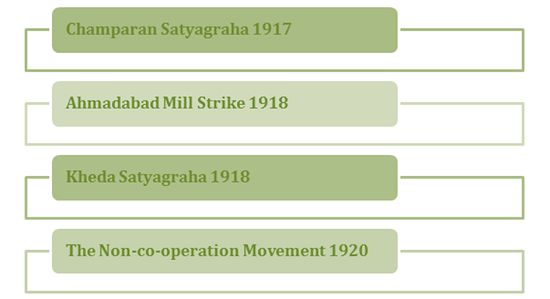

India got freedom after the contribution of lots of freedom fighters. Mahatma Gandhi was one of the Indian freedom fighters who believed in non-violent movements to force the Britishers to quit India and bring freedom. He also emerged in the political strategy in India due to his ability of leadership skills.
Gandhi’s return to India from South Africa in 1915 added significant changes to bring freedom to India. He performed as a leader in the national campaigns that had demanded Swaraj or brought freedom for India, along with women's rights, relaxing poverty, and amity for religious matters.

Figure 1: Gandhi’s movements
The Indian National Congress (INC) was the only political aspect of India that allowed the people to express their notions to bring freedom to India. Gandhi reformed the INC and transformed it into the most effective political organisation for the nationalism aspect of India
The movement of the Satyagraha in Champaran, Bihar was the first civil disobedience activity conducted by Gandhi to demand a free India. The conduction of this movement became practical to protest the poor circumstances of the farmers in Bihar. He went to Bihar in 1917 to scrutinise the consequences and demands of the poor farmers due to the forceful plantation of indigo in their lands by the British planters.
The farmers were mourning under the policy of the Britishers to collect a high amount of taxes. The British policy of the tinkathia system made the farmers cultivate indigo forcefully where the farmers were facing losses. Gandhi reached Champaran and asked the British planters to leave the place. He gathered farmers in masses to protest against such activities. He appeared in court and filed a case against the Britishers to relieve the farmers. The peaceful protest led by Gandhi, made the government agree to void the tinkathia policy.
After the peaceful conduction of this movement, the farmers received money as compensation from the Britishers. This movement was the first conduction of the peaceful movement by Gandhi also known as the Satyagraha. During this period, the people of Champaran called him Bapu.
Gandhi utilised the hunger strike and peaceful protest in an industrial conflict between the employees and the owners of the cotton mill placed in Ahmadabad in 1918. The conflict occurred as the owners wanted to stop providing the bonus to the employees and the employees had the demand to increase their remuneration by 35%.
The peaceful and hunger strike was showcased by Gandhi to support the employees for making their demands to practical. The strike became successful as the owners of the mil agreed to increase the employee’s remuneration by 35%.
Farmer's failure to produce enough crops due to droughts in 1918 remained a failure for the cultivation by the farmers of Kheda district in Gujrat. The farmers were supposed to receive a cancellation order during this time to pay the debt for a quarter, as the crop production was not successful. Even after knowing about the droughts, the government of Britain rejected any remission of taxes on the lands.
Sardar Vallabhbhai Patel constructed a protest against the farmers fighting against the policy to collect taxes under land revenue at the time. The protest was followed by the guidance of Gandhi and it remained a non-violence activity. During this protest, people from different types of cast joined this group.
The British government failed to resume their orders and was forced to withdraw the taxation policy. Additionally, they paid extra compensation and fulfilled the demands showcased by the farmers. The ideology of Gandhi was marked as a most effective change in people’s behaviour. Satyagraha became a role model in the Indian freedom struggle
Gandhi launched the non-cooperation movement to protest the incident of the Jallianwala Bagh. He made the member of INC united for the development Indian freedom struggle. Additionally, Gandhi persuaded people for initiating the non-cooperation movement with the application of the peaceful strategy which is the key element to attaining liberation.
Gandhi was able to frame the demand of the Indians to make free from the colonial practice of the Britishers. Another motive of the movement was to boycott foreign products and making of Indian products to replace them in the market. This movement became successful and then due to the Chauri Chaura incident happening when local people killed 23 police, Gandhi withdrew from the movement.
Gandhi made several movements to showcase the demand for a free India. The followings are the vital movements by Gandhi
Civil-Disobedience Movement in 1930
Dandi March in 1930
Quit Indian in 1942
The above movements made significant actions above the colonial strategies of the government of Britain and they left India in 1947.
Gandhi made INC the way of contact with the British rulers to submit the demands for Indian freedom. He marched several times with Indians to express his demands for freedom. He was elected as President of INC from 1924 to 1925 and remained an integral part of the INC till his death.
Q1. What occurred in the mill strike in Ahmadabad?
The mill strike in Ahmadabad was conducted to support the workers of a textile industry were fighting to get financial justice. The owners of the mill agreed to the demands of increasing remuneration for the employees instead of discontinuing bonuses.
Q2. What did occur in Dandi March?
Gandhi broke the law of producing Salt from seawater in 1933. A civil intractability march was also a peaceful movement.
Q3. What was the Quit India movement?
Gandhi demanded to leave India to the British rulers and bring independence to the nation. This movement was conducted in 1942 and it was one of the peaceful activities to achieve national freedom.